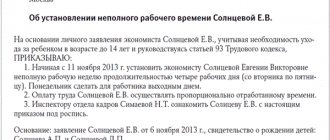The transfer of an employee to another organization can be carried out for various reasons. For example, production necessity, encouraging a person’s work and improving his qualifications, the need to fill an empty vacancy, employee dissatisfaction with the employer’s wishes and many others.
Transfer to another organization can be carried out at the initiative of both the employee and the employer. The main condition is the written consent of the personnel to this action . External transfer differs from other types of transfers in that labor relations with the management of the first organization are severed, and with the management of the second they arise.
Another organization can be absolutely any form of employer: an individual or legal entity, public or private enterprise. These organizations may have one or different founders, one or different departments. This does not make any difference to the translation procedure. It must be remembered that branches and other divisions of an enterprise are not another organization, therefore a transfer from one branch to another is not a transfer to another organization.
Types of transfers
Labor legislation provides for the possibility of transferring an employee of two types.
With an internal transfer, the employee is registered in the same organization, but either moves to another unit (for example, department), or begins to engage in another activity with a change in position. It happens that the organization itself changes its actual address. Then the employee’s start of work in another locality is also accompanied by a transfer. Internal transfer is allowed on a temporary or permanent basis.
An external transfer involves a change of employer. In this case, the new position upon transfer can only be permanent.
External transfer is allowed only with the consent of the citizen himself.
For internal transfers, the law in some cases makes exceptions, allowing the employer to make such a decision unilaterally (Article 72.2 of the Labor Code of the Russian Federation). We are talking about emergency cases that require immediate action, for example, accidents, disasters, etc.
The essence of transition to another position from the point of view of the Labor Code of the Russian Federation
Any horizontal or vertical movement of an employee within the company structure will in any case entail a change in his job function. For personnel records management in such a situation, it is important that a change in the job title and, as a consequence, the employee’s responsibilities, will be recognized as a change in the essential working conditions.
Expert opinion
Kozlov Nikita Vladimirovich
Practitioner lawyer with 7 years of experience. Specialization: family law. Legal expert.
This is due to the fact that the labor function in accordance with Art. 57 of the Labor Code of the Russian Federation refers to mandatory conditions of an employment contract and the employer cannot change it unilaterally.
Changing the essential terms of an employment contract is possible only by mutual agreement of its participants (Article 72 of the Labor Code of the Russian Federation), with the exception of certain cases specified by law, when the employee’s consent is not required.
Reaching such an agreement between the employee and the employer must be formalized in writing. In practice, for these purposes, the parties sign an additional agreement to the employment contract.
Circumstances as a result of which an employee may change position may be the following:
- Increase due to performance at work;
- Transfer to a lower position due to significant violations in work;
- Temporary replacement of an absent employee, whose job is retained;
- Transfer to another job due to medical reasons.
Regardless of the reasons that caused the change in the labor function, the company’s procedure for documenting will be the same.
On whose initiative the translation can be made
If the transfer is carried out at the request of the employee himself, the basis for issuing the order will be the citizen’s application. To avoid misunderstandings, in this case it is recommended to obtain written confirmation of the upcoming employment from the future employer, otherwise - an invitation.
In this case, the specialist can be sure that he will be hired for a new position no later than in a month, and he will be paid for relocation if necessary.
In any case, you should inform the potential employer in advance about your desire to receive a transfer. The entry in the work book will contain an indication of the employee’s own desire. In case of transfer, the new employer does not have the right to refuse to hire the citizen. If there is a refusal to conclude an employment agreement, the organization will face penalties.
When transferring, the law provides another guarantee - new employees are prohibited from installing a test.
An employee who wishes to move to another organization is required, as a general rule, to work for a specified period, which is a maximum of 14 days. The reason is to respect the interests of the employer, who will need time to select a new employee to replace the departing one.
It happens that the transfer occurs within the framework of an agreement between cooperating companies. For example, an organization ceases its activities, but wants to employ its employees by transferring them to vacant positions. Then, taking into account the consent of the employees, an appropriate agreement is drawn up.
First, the administration of the closing enterprise sends a request to the second employer regarding the possibility of transferring a specific person. A request for several specialists at the same time is allowed. If the second organization agrees, it confirms this with a response letter. Then the first employer issues an order(s) regarding dismissal.
Normative base
The current legislation in the field of labor relations, which regulates the transfer of an employee within an organization to another position, consists of several parts, namely:
- Labor Code , which directly regulates the legal issues of transfer, including the timing of such transfer. Specific regulation is carried out using articles 72.1 and 72.2 of this regulatory act;
- rules for drawing up work books in terms of regulating the issue of recording the transfer in this document when making a transfer, including one that is temporary. In addition, it is these Rules that talk about what to do if, for some reason, entries were made in the work book that should not be there.
How to properly transfer an employee to a new company
Step-by-step instructions for transferring an employee look like this.
Stage 1. Proposal of translation. An employee who is expected to be transferred to another company is notified of this possibility in writing. The letter must contain clear conditions of the proposed job: title of position, amount of payment, etc.). This procedure, like the subsequent ones, is repeated for each specialist.
Stage 2. Obtaining documented consent of the employee. Consent must be expressed in writing.
It is allowed to draw up a separate document with the signature of the employee or make an appropriate entry of consent on the received notification.
Stage 3. Issuing orders and formalizing labor relations with the new employer.
Current instructions require the use of approved forms to complete the transfer.
You will need to do the following:
- the former employer - issue an order regarding the dismissal of one or more employees using form T-8 or T-8a, respectively. The forms were introduced by the State Statistics Committee of the Russian Federation (Resolution No. 1 of 01/05/2004). Form T-8a is intended for registration of dismissal of several persons. In the column intended to indicate the grounds for termination of the contract (agreement), information about the transfer to another organization should be entered. For example, in this form: “Transfer at the request of the employee to the Niva Closed Joint Stock Company.” When indicating the date of termination of the employment contract, you should enter the date preceding the day of admission to the new company. When entering information about the basis document, you can use the details of the transfer offer submitted to the employee, on which he confirmed his consent in writing. It is recommended that this document be considered an annex to the order;
- for a new employer - to conclude an employment contract with an employee who comes as a transfer from another organization in accordance with the requirements of Art. 57 Labor Code of the Russian Federation;
- if we are talking about hiring several workers at the same time, it is recommended to use the T-1a form approved by the previously specified Resolution.
Employees must familiarize themselves with each of the orders and sign for it, as prescribed by the provisions of Art. 84.1 and 68 Labor Code of the Russian Federation.
Stage 4. Entering data into work books in accordance with the Rules established by Decree of the Government of Russia No. 225 of April 16, 2003.
Important! Entries in the record book of an employee dismissed due to a transfer include:
- information about dismissal due to transfer in accordance with Art. 66 Labor Code of the Russian Federation. The same entry is duplicated in the employee’s card according to the T2 form. Entries in the employee’s book and his dismissal card are accompanied by a mandatory signature from the citizen that he is familiar with them (clause 12 and clause 35 of the previously mentioned Rules);
- information that the employee has been accepted into another organization in accordance with the transfer procedure.
Stage 5. Payments to employees on the day of dismissal.
Watch the video. How to properly process an employee transfer:
New place - new contract
Initially, the transfer of an employee to another organization does not have clearly defined legislative regulation. Articles 56 and 57 of the Labor Code of the Russian Federation (hereinafter referred to as the Labor Code of the Russian Federation) indicate that the conclusion of an employment contract occurs between a specific employee and a specific employer.
Thus, if an employee moves from one organization to another, changing employer, he must first be dismissed from his previous place of work and must undergo an official registration procedure at the new place of work.
Why then is it necessary to prepare a translation? The transfer of an employee gives him and his future employer several advantages:
Firstly, the employee is absolutely sure that after leaving his old job, he is 100% guaranteed a place in the new one. He already has a preliminary agreement with the new employer, knows his salary level and is familiar with the work schedule.
Secondly, the new employer gets the desired employee. By hiring him, the employer is confident in the employee’s qualifications, knows about his skills and has a specially prepared workplace.
Thirdly, the old employer receives some kind of compensation. Perhaps it has a material expression, perhaps there was an exchange of employees between employers. There are a lot of options to motivate an employer to transfer an employee to another organization.
What payments to employees upon transfer are due?
If the dismissal of an employee is accompanied by his transfer to another company, he is entitled to the following amounts:
- salary. Salary is calculated for all days worked in the month;
- compensation due for the remaining days of vacation;
- certificates of incapacity for work that have remained unpaid up to this point.
A transfer to another employer does not provide for payment of severance pay to the citizen.
In each case, the calculation has separate nuances. So, for example, if the organization provides bonus payments, the employee dismissed as part of the transfer is also entitled to them. In each case, the provisions of the agreement in force between the parties and the local acts of the organization are taken into account.
Attention! Our qualified lawyers will assist you free of charge and around the clock on any issues. Find out more here.
Employees' right to leave
Since the dismissed employee receives compensation for the remaining unspent vacation days, at the new workplace, the calculation of the length of service for the right to vacation begins again. Article 122 of the Labor Code of the Russian Federation determines that the employee has the right to receive leave 6 months after the start of work in the organization. When translating, the same procedure applies.
Sometimes employees have a desire to negotiate with employers to preserve the time worked in order to obtain the right to vacation by waiving compensation. This seems easy, especially if the two companies have the same founder.
Please note! The law is strict in this regard: such refusal of compensation is not allowed.
What happens to vacation?
The vacation is not saved during the transfer, so to go on vacation, a citizen must work in the new company for at least six months. If there are several days of rest left at the previous place of work, which the specialist did not take advantage of, then he is paid only compensation, the amount of which depends on his average earnings.
Only a minor employee or an employee who has adopted a child less than three months old can take early leave at a new job.
Will the transfer affect the rights of employees to pensions and sick leave?
Many working citizens are concerned about whether a transfer to another organization will affect the length of service required to assign the required pension or the payment for sick periods. You can be calm about this.
According to the current procedure, insurance coverage is taken into account when calculating pension benefits, and we are not talking about continuous service here at all. Therefore, only the duration of the employee’s work activity, confirmed by the necessary documents, is important.
When transferring, usually dismissal from one company and admission to another occurs without a temporary break. That is, a citizen, for example, was fired on February 1 and hired on February 2. In this case, there is no loss of insurance experience at all.
With regard to payment of sick leave, the procedure is almost the same. Since 2007, the law has required that only insurance coverage be taken into account when calculating sick leave. Continuity of employment does not matter in this case. In addition, as mentioned above, when transferring, admission to a new organization usually occurs immediately after dismissal, so that seniority is not lost.
How to properly accept a transferred employee
The employer needs to remember that Article 70 of the Labor Code prohibits introducing a test when hiring a specialist transferred from another organization.
When filling out an admission order, it is recommended to use the T-1 form. In the column provided for this, you must enter that the reception is carried out as part of the transfer.
The order and the concluded employment agreement must contain the same conditions that were indicated in the invitation to work or other similar document regarding the transfer. It is important to fully comply with the previously specified position, salary, working conditions, etc.
Rules for drawing up an application by an employee
Before completing the transfer, you must obtain permission for this process from the direct hired specialist. To do this, they draw up a special resignation letter, which includes the following information:
- the name of the director of the enterprise to whom this application is sent;
- personal data about the employee, provided by his full name, position held and information from his passport;
- indicates the need to transfer to another company;
- it is stated that there is an official job offer from another organization;
- a request is made to format the translation correctly;
- The date of document generation and the employee’s signature are indicated.
It is advisable to hand over the document personally to the employer. A sample of such a statement can be found below.









